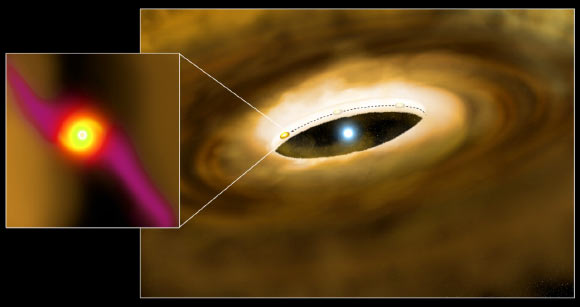Astronomers headed by Dr Sean Brittain of Clemson University have discovered evidence of a huge extrasolar planet forming around the young star HD 100546.

An artist’s conception of the young massive star HD100546 and its surrounding disk. A planet forming in the disk has cleared the disk within 13 astronomical units of the star, a distance comparable to that of Saturn from our Sun. As gas and dust flows from the circumstellar disk to the planet, this material surrounds the planet as a circumplanetary disk (inset). These rotating disks are believed to be the birthplaces of planetary moons, such as the Galilean moons that orbit Jupiter. Image credit: P. Marenfeld / NOAO / AURA / NSF.
HD 100546, also known as KR Muscae, is a so-called Herbig Be star located about 335 light years from Earth.
Dr Brittain and his colleagues set out to study the protoplanetary disk around the star.
They were studying the warm gas in this disk using a technique called spectro-astrometry, which allows astronomers to detect small changes in the position of moving gas, and discovered an ‘extra’ source of gaseous emission from carbon monoxide molecules that could not be explained by the protoplanetary disk alone.
By tracking the changes in velocity and position of this extra emission over the years of the observations, they were able to show that a massive planet is orbiting around HD 100546. The distance from the star is about 13 astronomical units – somewhat larger than the distance of Saturn from the Sun.
The evidence suggests that the team is observing hot gas that surrounds an orbiting young planet.
Through modeling carried out by the astronomers, and with additional data gathered to confirm their initial hypothesis, they were able to investigate the extra emission as it orbited the star.
They concluded that a likely explanation for the observations is a small circumplanetary disk of hot gas orbiting a forming planet.
The candidate planet would be a gas giant at least three times the mass of Jupiter.
The theory is that material from the large protoplanetary disk feeds into the circumplanetary disk, which then feeds onto the growing planet. Hence, a circumplanetary disk plays a mediating role in the growth of the planet.
The remnants of a circumplanetary disk could also give birth to moons, such as those seen around Jupiter in our Solar System.
A novel aspect of this new evidence for planet formation is the possible detection of a circumplanetary disk.
The findings appear in a paper in the Astrophysical Journal (arXiv.org pre-print).
The scientists plan to continue to monitor the motion of the planet and obtain additional data to better define the properties of the circumplanetary disk.
They predict that the planet and its disk will disappear from view in about two years time when they become hidden by the inner edge of the circumstellar disk. So, if the model is correct, the signature of the orbiting planet will not be seen for another 15 years until its orbit brings it back into view.
_____
Sean D. Brittain et al. 2014. NIR Spectroscopy of the HAeBe Star HD 100546. III. Further Evidence of an Orbiting Companion? ApJ 791, 136; doi: 10.1088/0004-637X/791/2/136







